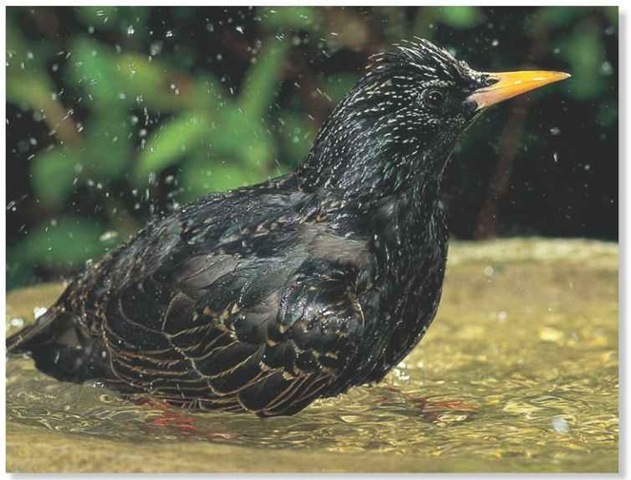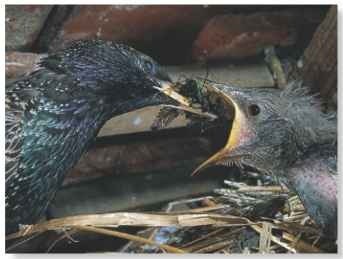ORDER
Passeriformes
FAMILY
Sturnidae
GENUS & SPECIES
KEY FEATURES
• One of the world’s most successful birds; thrives in the U.S. and many cities in Europe and Asia
• Bold and boisterous; in winter it gathers into huge, noisy roosting flocks
• Song is a mixture of trills and ratties — it also mimics other birds and mechanical sounds
WHERE IN THE WORLD!
Britain and mainland Europe, and much of Asia; introduced in-North America, South Africa, Australia and New Zealand

LIFECYCLE
Often despised for its domineering ways, the European starling compensates with the dramatic beauty of its aerial maneuvers as it gathers in vast flocks on winter evenings.
Habitat
Few birds are as adaptable as the European starling. It thrives from Arctic tundra to the Australian Outback, and breeds at altitudes of up to 6,600′. In the U.S., it is as much at home in New York City parks as it is on cattle ranches of the west.
The starling occurs in cities, suburbs and lightly wooded country, but rarely enters dense forest unless attracted there by plagues of caterpillars or flying ants. The bird generally avoids evergreen plantations, except when it is roosting. The starling prefers open spaces in which to feed, but it may frequent coastal marshes and rocky shores.
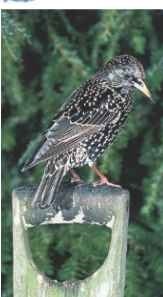
A Digging the garden The starling scans lawns and flowerbeds for food.
Breeding
LIFE IN THE CITY
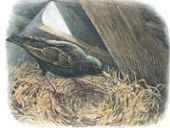
Builder at work…
The male builds the nest before finding a mate. He uses straw, grass and small twigs to construct the foundations.
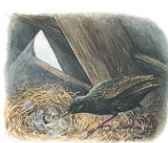
Soft furnishings…
Attracted by the male’s display, a female-lines the nest with moss and feathers. The male may also add some fresh leaves or flowers.
A superb mimic, the starling is very closely related to the mynah of Asia.
Flocks of starlings are called “murmurations.”
• In 1890, 120 starlings were released in the United States. The North American population now numbers many millions.
Behavior
The European starling is unpopular with many people because of its apparent greed and aggressiveness when fighting over scraps at bird feeders — but such traits contribute to its success as a species. Alert and wary, the bird seldom becomes tame, even in towns.
By living in flocks, the starling increases its chances of spotting and avoiding predators. The greatest congregations assemble at dusk in winter, when flocks leave their feeding grounds to join a communal roost. Like a vast, billowing cloud, they wheel across the sky, swirling in unison before landing. The noise increases as each flock flies in, adding more warbles and whistles to the clamor.
Reed beds are favorite roost sites, although the fragile stems often collapse under the weight of so many birds.
Starling swarm Flocking starlings are an awe-inspiring sight.
Conservation
The European starling has spread with the growth of cities, but has suffered in the country due to pesticides and modern farming methods. The U.S. population is stable, but the British population has declined since the 1970s.
The male starling’s choice of nest site varies by habitat, but it is always located in a cavity. In cities, many nests are built in holes in buildings or under the eaves of roofs. Natural sites include tree holes made by woodpeckers and tunnels excavated by sand martins; the starling often evicts other species from their new nests. The bird also occupies crevices in cliffs and rocks.
Once he has built the nest, the male attracts a female with a frenzy of singing and wing fluttering. After mating, and while the female incubates the eggs, the male may build another nest, to which he attracts a second female. He helps rear the two broods simultaneously.
Both sexes feed the chicks, which signal hunger with loud calls and gaping, yellow mouths.The young continue to beg after leaving the nest, often tripping in their eagerness to be fed.
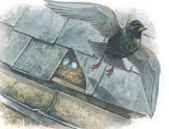
Synchronization…
The female delays incubation until her clutch is almost complete. She leaves the nest unguarded between the laying of each egg.
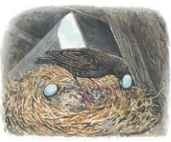
Opportunism
Another female finds the nest and replaces an egg with one of her own.This often occurs during nest-site shortages.
Food & feeding
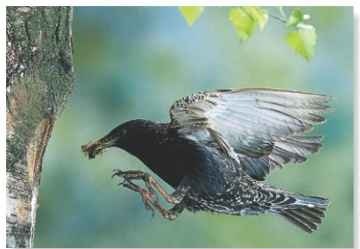
A Successful hunting Nestlings need the protein provided by insect food.
The starling’s diet consists mainly of insects and other invertebrates. When autumn arrives, it turns to berries, soft
fruit and grain, together with peanuts, bread, and other bird-feeder scraps. These foods sustain the bird throughout the fall and winter when other food is scarce.
The starling has a special method for unearthing prey. Highly developed jaw muscles enable the bird to force open its bill after pushing it into the soil and snatching prey. The bird also follows grazing animals in search of insects disturbed by their hoofs. The starling’s most spectacular hunting method can be seen in summer, when it swoops, twists and glides to catch flying insects.

PROFILE
European Starling
Swift and direct in flight, the European starling has short, triangular wings and a stubby tail that give it the look of an arrowhead.

Creature comparisons
In contrast to the European starling, which at a distance appears to be a uniform black, the Daurian starling (Sturnus sturninus) looks predominantly white from afar Its pale-gray head and underparts are set off by a patchwork of purple, green, brown and buff on its back and wings. At 7″ long, it is smaller than the European starling but shares its cousin’s jaunty, upright stance.
The Daurian starling breeds in northeastern China and adjoining parts of Russia, before migrating to winter feeding grounds in tropical southeastern Asia.
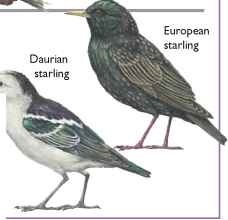
| VITAL | ||
| STATISTICS | ||
| Weight | 2.5-3 oz. | |
| Length | 8.5-9″ | |
| Wingspan | 15-17″ | |
| Sexual | 1—2 years | |
| Maturity | ||
| Breeding | April—June | |
| Season | ||
| Number | 4-7 | |
| of Eggs | ||
| Incubation | 11-15 days | |
| Period | ||
| Fledging | 20-22 days | |
| Period | ||
| Breeding | 1-2 broods | |
| Interval | a year | |
| Typical | Insects, | |
| Diet | worms, fruit, seeds | |
| Lifespan | Up to 20 years |
|
RELATED SPECIES
• The European starling is I of 16 species in the genus Sturnus, including . the rosy-colored starling, . S. roseus (below), a native of Asia and southeastern Europe. Starlings are in the family Sturnidae, which includes grackles and oxpeckers.

